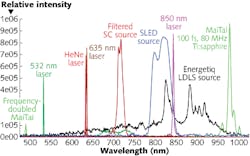By combining static interferometry and optical-fiber processing, passive interferometer engine (Pie) technology—called the Swiss army knife of optical measurement by its developers at Pie Photonics (Tullamore, Ireland)—measures optical frequency, phase, delay, and amplitude for any narrow or broadband optical light source in a single, static, mobile unit. Using a photonic circuit and a 3648-element camera, Pie-in-a-box captures 500 nm of information with 1 nm resolution in a single click. The resolution is set by the sampling density of the captured interference fringes and number of pixels available—for example, 700 nm light at a sampling density of three pixels per fringe and 3648 pixels across the camera means Pie can achieve an optical-path-delay length of 0.85 mm and a resolution of 0.6 nm.
To produce an interferogram with the Pie engine, individual wavetrains are divided between the arms of a fiber interferometer and then—having traveled similar distances through similar arms—light from respective arms diffracts onto a screen and overlaps. In general, the greater the separation between the exit apertures, the greater the number of interference fringes and the higher the resolution that can be achieved. Pie Photonics has also developed MyPie by interfacing Pie technology with a modified iPhone using a physical photonic-lantern interface (a tapered structure that allows a multimode optical fiber to couple to singlemode components) to demonstrate “smart” mobilization of interferometry. Contact Dominic Murphy at [email protected].

